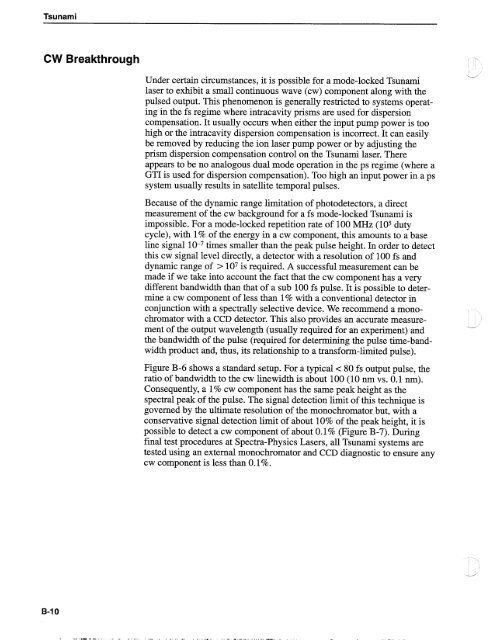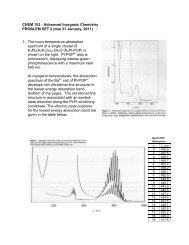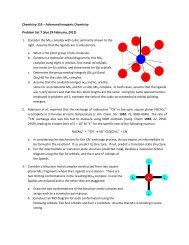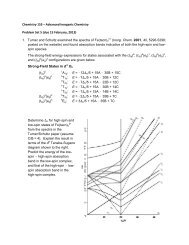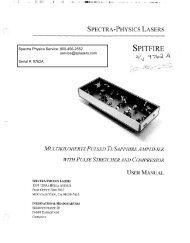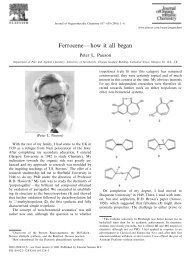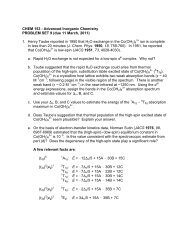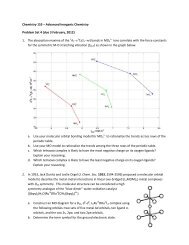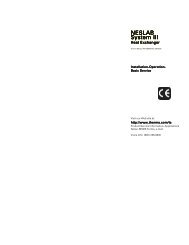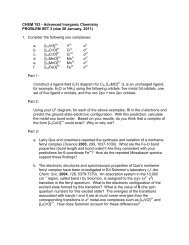Tsunami - Beckman Institute Laser Resource Center
Tsunami - Beckman Institute Laser Resource Center
Tsunami - Beckman Institute Laser Resource Center
Create successful ePaper yourself
Turn your PDF publications into a flip-book with our unique Google optimized e-Paper software.
<strong>Tsunami</strong><br />
CW Breakthrough<br />
Under certain circumstances, it is possible for a mode-locked <strong>Tsunami</strong><br />
laser to exhibit a small continuous wave (cw) component along with the<br />
pulsed output. This phenomenon is generally restricted to systems operating<br />
in the fs regime where intracavity prisms are used for dispersion<br />
compensation. It usually occurs when either the input pump power is too<br />
high or the intracavity dispersion compensation is incorrect. It can easily<br />
be removed by reducing the ion laser pump power or by adjusting the<br />
prism dispersion compensation control on the <strong>Tsunami</strong> laser. There<br />
appears to be no analogous dual mode operation in the ps regime (where a<br />
GTI is used for dispersion compensation). Too high an input power in a ps<br />
system usually results in satellite temporal pulses.<br />
Because of the dynamic range limitation of photodetectors, a direct<br />
measurement of the cw background for a fs mode-locked <strong>Tsunami</strong> is<br />
impossible. For a mode-locked repetition rate of 100 MHz (105 duty<br />
cycle), with 1% of the energy in a cw component, this amounts to a base<br />
line signal 10-7 times smaller than the peak pulse height. In order to detect<br />
this cw signal level directly, a detector with a resolution of 100 fs and<br />
dynamic range of > lo7 is required. A successful measurement can be<br />
made if we take into account the fact that the cw component has a very<br />
different bandwidth than that of a sub 100 fs pulse. It is possible to determine<br />
a cw component of less than 1% with a conventional detector in<br />
conjunction with a spectrally selective device. We recommend a monochromator<br />
with a CCD detector. This also provides an accurate measurement<br />
of the output wavelength (usually required for an experiment) and<br />
the bandwidth of the pulse (required for determining the pulse time-bandwidth<br />
product and, thus, its relationship to a transform-limited pulse).<br />
Figure B-6 shows a standard setup. For a typical c 80 fs output pulse, the<br />
ratio of bandwidth to the cw linewidth is about 100 (10 nm vs. 0.1 nm).<br />
Consequently, a 1 % cw component has the same peak height as the<br />
spectral peak of the pulse. The signal detection limit of this technique is<br />
governed by the ultimate resolution of the monochromator but, with a<br />
conservative signal detection limit of about 10% of the peak height, it is<br />
possible to detect a cw component of about 0.1% (Figure B-7). During<br />
final test procedures at Spectra-Physics <strong>Laser</strong>s, all <strong>Tsunami</strong> systems are<br />
tested using an external monochromator and CCD diagnostic to ensure any<br />
cw component is less than 0.1%.<br />
d<br />
--


